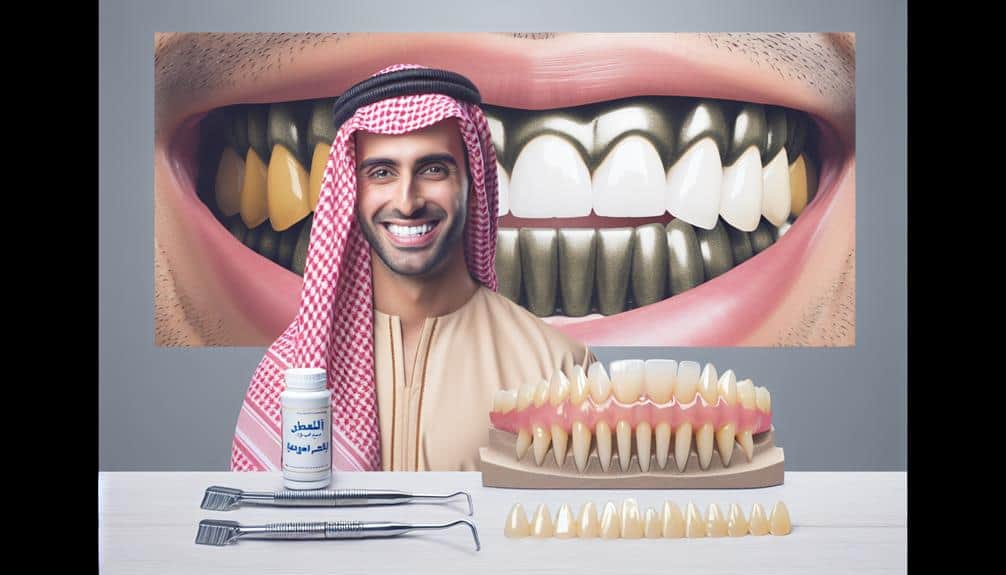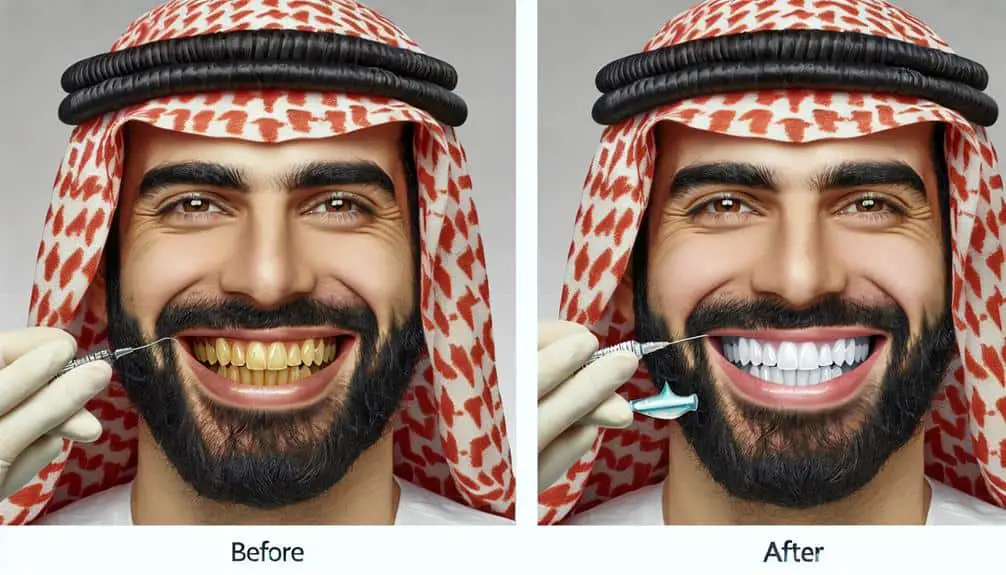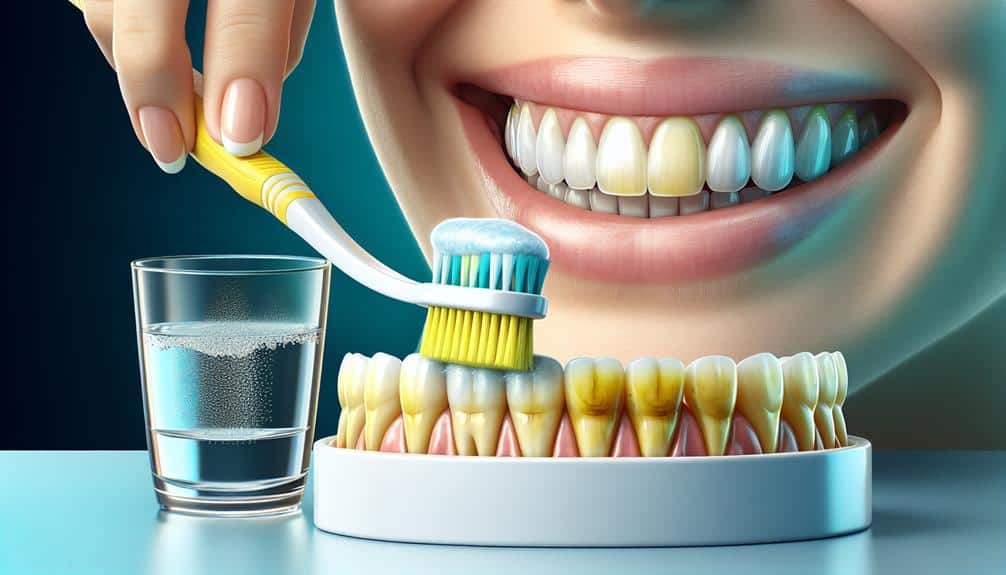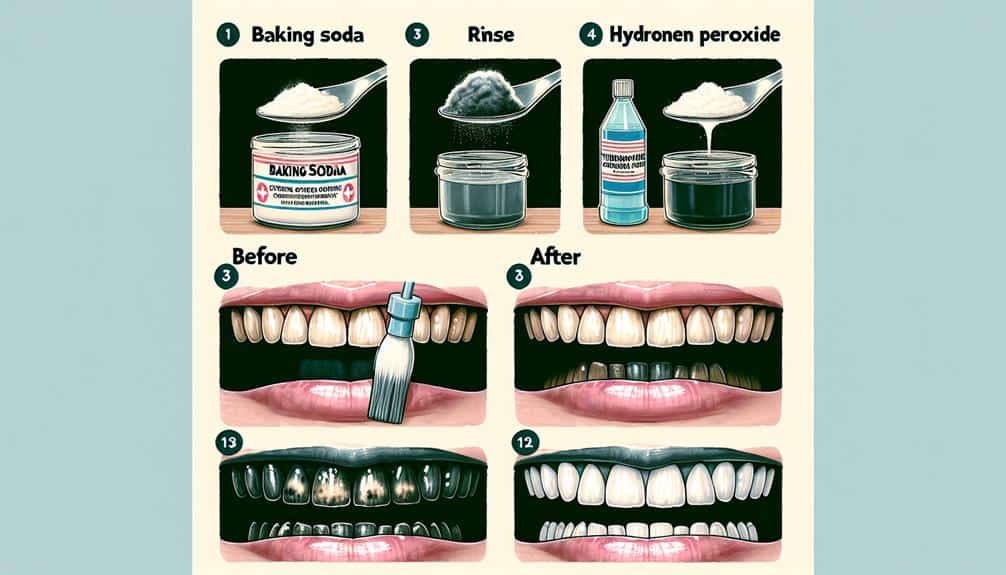Transform your smile with top whitening solutions for tetracycline-stained teeth. Consider professional in-office bleaching for effective removal. Laser therapy targets deep stains efficiently. At-home kits and whitening strips offer convenient alternatives. Try natural remedies like neem or baking soda cautiously. Maintain whiter teeth with good oral hygiene practices and regular cleanings. Dental professionals can guide you on the best whitening approach for your needs. Upgrade your smile confidently with these transformative solutions.
Key Points
- Professional in-office bleaching effectively removes deep tetracycline stains.
- At-home whitening kits with gel and trays offer convenient stain lightening.
- Laser therapy targets and treats tetracycline stains for quicker results.
- Natural remedies like neem and baking soda can help whiten stained teeth.
- Maintaining oral hygiene and avoiding staining foods are key to preventing tetracycline stains.
Understanding Tetracycline Stains
Have you ever wondered why tetracycline stains occur on teeth and how they impact the overall appearance of your smile?
Tetracycline stains are caused by the use of the antibiotic tetracycline during tooth development, resulting in a yellow or brown discoloration of the teeth.
These stains can be particularly vital to remove and may affect your confidence in your smile.
Prevention of tetracycline stains involves avoiding the use of tetracycline during pregnancy and in children under 8 years old to reduce the risk of staining developing teeth.
If tetracycline use is necessary, dentists can prescribe alternative antibiotics to prevent these stains from occurring.
Understanding the causes of tetracycline stains is essential in taking proactive steps to prevent them.
Professional Whitening Treatments
Professional whitening treatments offer effective solutions for removing stubborn tetracycline stains from teeth, restoring a brighter and more vibrant smile. In-office bleaching, a popular professional whitening method, involves applying a high-concentration bleaching agent to the teeth while protecting the gums and soft tissues. This procedure is typically completed in one visit and can greatly lighten tetracycline stains.
Laser therapy is another professional whitening option that can target deep-set tetracycline stains. This innovative treatment utilizes laser energy to activate the bleaching agent, enhancing its effectiveness in breaking down stubborn stains. Laser therapy is precise and can often achieve noticeable results in a shorter time compared to traditional bleaching methods.
When considering professional whitening treatments for tetracycline-stained teeth, consult with a dental professional to determine the most suitable option for your specific case. With the advancements in in-office bleaching and laser therapy, achieving a whiter smile, even in the presence of challenging tetracycline stains, is now more attainable than ever.
At-Home Whitening Options
Considering exploring whitening options for tetracycline-stained teeth at home offers a convenient and cost-effective alternative to professional treatments. When selecting at-home whitening solutions, keep in mind the effectiveness and safety of the products you choose.
Here are three recommended options:
- DIY Whitening Kits: These kits typically include whitening gel and trays that you can apply at home. They're designed to gradually lighten stains, including tetracycline discoloration. Make sure you follow the instructions carefully for best results.
- Toothpaste Alternatives: Look for toothpaste specially formulated for whitening stained teeth. These toothpaste options often contain gentle abrasives or whitening agents that can help reduce the appearance of tetracycline stains over time. Incorporate them into your daily oral care routine for noticeable results.
- Whitening Strips: Over-the-counter whitening strips are another popular choice for at-home teeth whitening. These thin strips are coated with a whitening gel and are applied directly to the teeth. They can be effective in treating tetracycline stains with consistent use.
Natural Remedies for Stained Teeth
Natural remedies offer effective alternatives for combating stained teeth, providing a holistic approach to improving dental aesthetics. Herbal remedies have been used for centuries to address various health concerns, including dental discoloration. For stained teeth, herbs like neem, sage, and thyme are known for their natural whitening properties. Neem, in particular, has antibacterial qualities that can help reduce stains caused by plaque buildup.
DIY techniques are also popular for those seeking natural solutions for stained teeth. Baking soda mixed with hydrogen peroxide creates a gentle abrasive paste that can help lift surface stains. Oil pulling with coconut or sesame oil is another DIY method that may help remove toxins and bacteria that contribute to discoloration.
While natural remedies can be effective, it's important to use them cautiously and consult with a dental professional to confirm they're safe for your teeth and gums. Incorporating these holistic approaches into your oral care routine may gradually help improve the appearance of stained teeth.
Tips for Maintaining Whiter Teeth
To maintain whiter teeth, establish a consistent oral hygiene routine that includes brushing and flossing daily. Regular brushing helps remove surface stains and prevents plaque buildup, while flossing removes food particles that can lead to discoloration between teeth.
In addition to these essential practices, consider the following tips to maintain your bright smile:
- Limit Staining Foods and Beverages: Cut down on coffee, tea, red wine, and dark berries that can stain your teeth over time. If you do consume these items, rinse your mouth with water afterward to help minimize staining.
- Use a Straw: When drinking beverages that may stain your teeth, like soda or juice, use a straw to minimize contact between the liquid and your teeth.
- Schedule Regular Dental Cleanings: Professional cleanings by a dental hygienist can help remove stubborn stains and prevent new ones from forming. Aim to visit your dentist at least twice a year for cleanings and check-ups.
Frequently Asked Questions
Can Tetracycline Stains Be Completely Removed With Whitening Treatments?
For tetracycline stains, whitening treatments can considerably lighten discoloration, but complete removal may be challenging. Prevention is key to maintaining whitening results. Regular maintenance and professional guidance can help manage tetracycline stains effectively.
Are There Any Potential Side Effects or Risks Associated With Professional Whitening Treatments for Tetracycline-Stained Teeth?
When contemplating professional whitening for tetracycline-stained teeth, be mindful of potential risks. Take precautionary measures to safeguard your dental health. Long-term effects and maintenance tips are essential for preserving your bright, stain-free smile.
How Long Do the Effects of At-Home Whitening Options Last on Tetracycline-Stained Teeth?
To maintain long term results of at-home whitening for tetracycline-stained teeth, follow these tips: Consistent use, avoid stain-causing foods, and touch up as needed. With proper care, effects usually last several months before requiring reapplication for best results.
Are There Any Specific Natural Remedies That Are Particularly Effective for Treating Tetracycline Stains?
When it comes to treating tetracycline stains naturally, some DIY remedies can be surprisingly effective. Natural alternatives like baking soda, activated charcoal, and hydrogen peroxide have shown promising results in brightening teeth and reducing discoloration.
What Are Some Common Habits or Foods to Avoid in Order to Prevent Further Staining on Whitened Teeth Affected by Tetracycline?
To prevent stains on whitened teeth affected by tetracycline, avoid habits like smoking and consuming dark-colored beverages like coffee or red wine. Make lifestyle changes by practicing good oral hygiene, using a straw for drinks, and scheduling regular dental cleanings.



